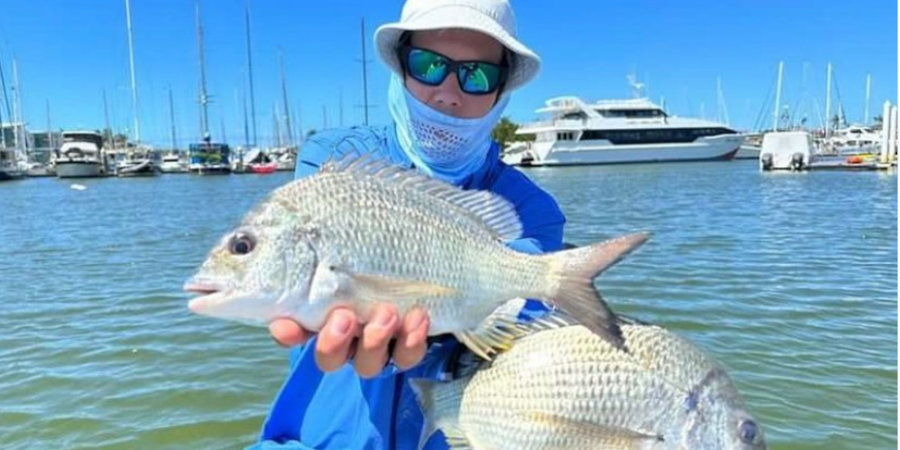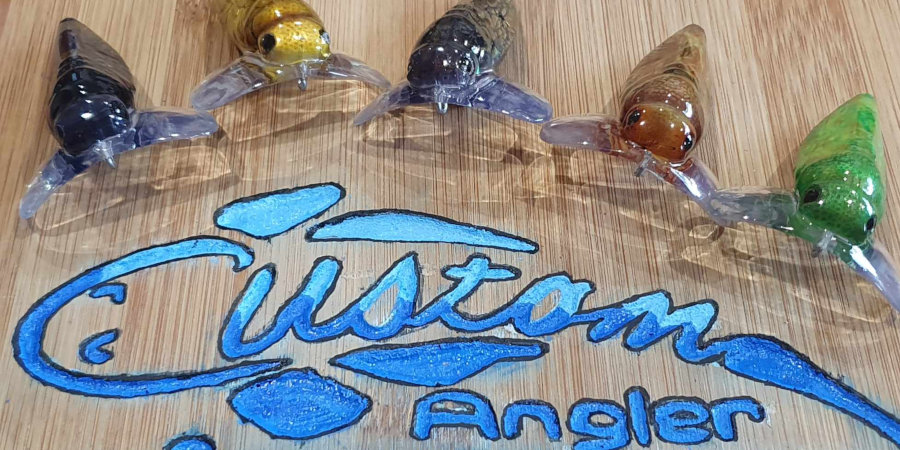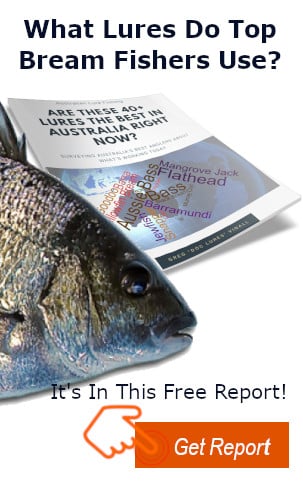
Paul’s Melbourne Bream Fishing Tips
- Bream are prevalent throughout the bigger river systems around Melbourne, such as the Yarra and Maribyrnong, but also in the smaller systems including the Werribee and Patterson. Good populations also occur in pockets around Port Phillip Bay, wherever structure occurs.
- In 2020 late spring rains have created unseasonal fresh water in the systems coming into summer and Paul reckons the evidence suggests that bream may have even engaged in a late second spawning. Early in summer Paul suggests looking in the smaller rivers, which tend to clear up faster after a flush.
- Paul’s idea of ideal conditions for bream fishing in this area would include a high tide around 8 am, overcast conditions and a very light breeze. This enables him to start the day by topwater fishing the flats – with the topwater bite sometimes extending a little longer if cloud cover persists.
- As the day progresses, Paul tends to move from the flats to the structure, such as bridges, pontoons, rock walls, hulls and other barnacle or oyster encrusted surfaces.
- Paul finds that fishing can be tough around the full moon as the fish seem to feed all night and become shut down during the day. He’s had very little success on bream after dark, although he has no problems catching other species at night.
- When the sun gets up Paul looks for shadowy areas around structure with some water flow. Bream will hide in wait in the shadows waiting for the current to bring food.
Paul’s Suggested Bream Fishing Tackle
- 7’ medium/light spin rods in the 1-3 or 2-4 kg class are ideal. Paul couples these with 2000-2500 size reels, braided line and 6lb leaders. If the fishing is tough, he’ll sometimes drop down to a 4 lb leader. Paul hasn’t found straight through fluorocarbon to be advantageous around Melbourne, in fact it can be disadvantageous.
Pauls Best Melbourne Bream Fishing Lures
- The 76mm OSP bent minnow is the first lure Paul likes to start with when the conditions are right. He likes the pink head with chartreuse and white body. He’ll fan casts out over the flats and/or close to structure and let the lure sit stationary until the rings dissipate, then work the lure with 5-8 sharp twitches followed by a pause until the rings dissipate. If you observe boils or bow waves behind the lure but don’t get a bit then try different retrieves until you figure out what’s working on the day.
- The 38mm Atomic Hardz Crank is a very buoyant, snag resistant and relatively shallow running lure that Paul likes for fishing the flats when there is a bit more ripple on the water and the OSP bent minnow becomes less effective. Slow rolling it close to the bottom is very effective, or if the bottom is sand or mud, allowing it to strike the bottom and throw up puffs of sand/mud works well too.
- The Damiki Monster Miki is a great little soft plastic lure in cinnamon or motor oil colours that can be fished on very light jig heads to fish holding in shadows around structure. Paul suggests jig heads from size 2-4 in weights from 1/16 oz to 1/40 oz work best. He casts the lure into a pocket of shade in areas where the flow brings food, lets them sink a little and works them with short, aggressive twitches. Don’t forget to separate the claws from the body before fishing these lures.
- The Cranka Crab is a good option when the fish are down deeper and are out of sight, especially when the fish are in the lower 1/3 of the water column. Paul likes to cast these in areas where he can drift them down the face of structure like a sinking crab and then allow them to drift and waft close to bottom.
- 40mm Stick Minnows, in dark colours such as those marketed by Tiemco and Jiggle Fishing are great when the fish are holding close to structure in the top 1/3 of the water column. They are allowed to sink a little and then worked with short twitches to imitate a baitfish.
- The Ecogear SX40 hard body is an ever-reliable bream lure around Melbourne and is the perfect profile in this area for fishing around bridges, pontoons, rock walls and flats. It has a subtle rattle that attracts bream without spooking them. Paul likes a variety of colours from dark, natural to flashier options.
Paul Malov
Sponsored Tournament Angler
Paul is a tournament bream specialist who won the ABT Grand Final in 2013 with his father. He also won the Victorian Bream Classics Team Series team of the year in 2010, 2012, 2014 and 2015 and represented Australia in Louisiana for the Hobie Fishing Worlds 6 in 2016. A Melbourne resident, when he’s not fishing bream tournaments Paul is exploring previously untapped sport fishing opportunities around his home town – like winter snapper from a yak and luring mulloway, for example.
Paul’s Sponsors

Fishing In Hobart: A Bream Masterclass With Plinio And Deathy
Check out a swag of little known techniques and insights for fishing the Derwent River system for bream in this awesome interview with Plinio Taurian.

Fishing At Forster: 5 Top Spots With Local Gun Luke Austin
The fishing at Forster – Tuncurry is superb, all year round with numerous options for land-based and boating anglers alike. Luke Austin has lived there all his life and shares some great spots for visiting anglers and locals alike.
Unveiling the Secrets of Tuggerah Lake Fishing: Adam Amos on Bream
Tuggerah Lake Fishing is EPISODE 668. Check out our archives for more information on Bream Fishing!Introduction to Tuggerah Lake Fishing Tuggerah Lake, nestled on the NSW Central Coast, is a prime destination for bream fishing, easily accessible from Sydney. It's a...

Ben Monforte’s Revolutionary Approach to Moreton Bay Bream Fishing
Ever considered using Japanese Free Rigging techniques to target bream? That’s exactly what today’s guest Ben Monforte shares with us in a fascinating techniques-based interview.

On Yamba Bream, Pimping Lures and the WRFL With Laurie Anderson
Yamba can be an exceptional fishing spot – and bream are high on the list of targets for many anglers. Tournament fisho and lure customiser Laurie Anderson shares her tips and advice in this episode.

Fishing In Hobart: A Bream Masterclass With Plinio And Deathy
Check out a swag of little known techniques and insights for fishing the Derwent River system for bream in this awesome interview with Plinio Taurian.

Fishing At Forster: 5 Top Spots With Local Gun Luke Austin
The fishing at Forster – Tuncurry is superb, all year round with numerous options for land-based and boating anglers alike. Luke Austin has lived there all his life and shares some great spots for visiting anglers and locals alike.




Thanks Doc. A few colours to help narrow the search … that wasn’t so hard now was it ;-).
So, that’s the Damiki Monster Miki in Light Cinnamon (204) and Motor Oil Red (902). Check!
I’m now hoping Paul can chip in on whether the OSP Bent Minnow (P-74) is more effective when silent or rattling.
Also whether he prefers the Cranka Crabs (Olive and Glow) in light or heavy version given that the primarily focus is on the lower 1/3rd of the water column?